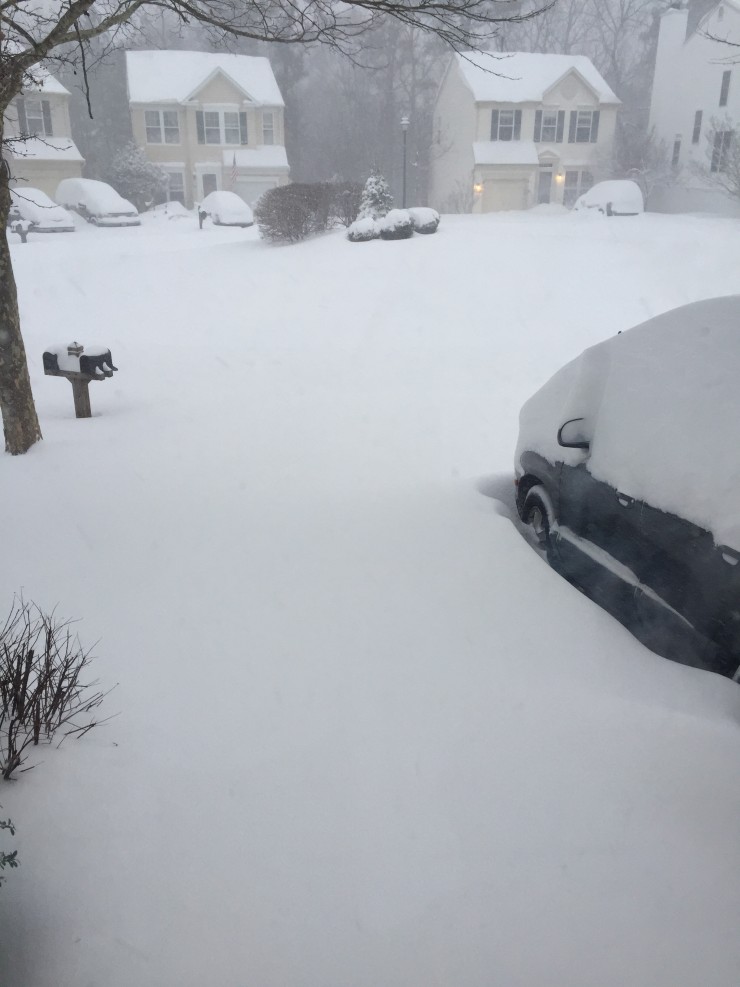
The view out my front door during #Snowzilla
This past weekend, the mid-Atlantic and Northeastern United States (and even some further south) experienced a historic snow event. Aside from travel challenges related to the storm, I’m thinking that a storm like this probably doesn’t bubble to the surface from a travel perspective. But I learned something interesting from this storm, and it very well may impact travel to an extent.
First, a few points about the storm called “#Snowzilla”
- This is perhaps the first storm that I can remember where we’ve had 7-10 days notice, and the various weather models stayed consistent all throughout the forecast.
- It impacted a lot of people. Airlines started cancelling flights Friday night, and as of writing this post, many airlines are not projecting a resumption of services until late Sunday or Monday, at least in the DC area.
- As far as snow accumulation – in the DC area, nearly 2 feet have fallen. The Weather Channel reports many other areas further north are in a similar position. Further to the south, many states got historic–albeit lesser–snowfall amounts.
The lesson and interesting factoid from #Snowzilla
Here in DC, the most reliable weather authority is the Capital Weather Gang of the Washington Post. For the past 3 or so years, I’ve turned to them, whenever a storm was forecast, and they have been generally right. They provide the science behind the forecast as well. Finally, they usually provide a detailed analysis. The level of information they provide, in my opinion, is more than you see from the more mainstream outlets, such as The Weather Channel.
So naturally, when I see a post from them like this:
Washington, D.C., snowfall total called into question after improper measurement https://t.co/u45IYLLghZ pic.twitter.com/OCgQstH4cZ
— Capital Weather Gang (@capitalweather) January 24, 2016
I can’t help but read it.
The key points from their post, at least for me were the following:
- The National Weather Service contracts to the FAA for weather observations (e.g. rainfall, snowfall, etc).
- There is a proper way to measure snowfall (using a board), after measurement, the board is cleared, to avoid inaccurate measurements due to compaction.
- Reagan National’s weather observer may not have followed standard procedures for measuring snowfall.
The biggest point for me though, is the first one. When I plan travel to a new place, I’ll usually look at the weather. The weather is usually measured at the airport. Granted that this may be an isolated incident, I still find it concerning that an airport, where I’d expect experts to know the right procedures, may have gotten it wrong. I mean, more people than just tourists wanting to know what to pack, rely on the weather. Pilots rely on the weather reports and measurements. So, this gives me some concern.
Conclusion
This was a big storm, that impacted a great deal of people in the Eastern US. I don’t want to minimize that. But, the fact that an authority on the weather, is coming out and questioning Washington, DC’s (ironically, located across the Potomac in Virginia) weather reporting site, is a big deal. I’m not saying that this means other airports may not follow procedures, and how well you can trust the data, but, it’s certainly poses the question.
Official FAA observations do not include snowfall totals. That is a function that the FAA contracts out to someone else. FAA Weather observations, known as METARs, are quite extensive and include wind direction/speed, visibility (with restrictions to the visibility if less than 7 miles, IE heavy snow) cloud levels and coverage, temp and dewpoint, Altimeter and RVR if available (runway visual range, measured via special equip. if available and reportable [<6000ft]) also includes remarks. For the DC area here is a link with the current METARs and the decodes for them.
http://www.aviationweather.gov/adds/metars/index.php?submit=1&station_ids=KDCA%20KIAD%20KBWI%20&chk_metars=on&std_trans=translated
@Dan, thanks for the clarification. I find it interesting that the NWS contracts to the FAA, and then the FAA Contracts out the snowfall totals, and I’d assume rainfall totals too?